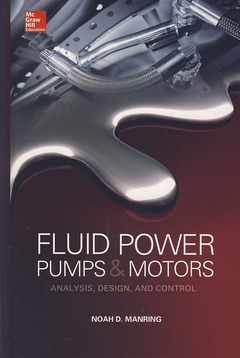Description
Fluid Power Pumps and Motors
Analysis, Design and Control
Author: MANRING Noah
Language: English
Subjects for Fluid Power Pumps and Motors:
Approximative price 99.03 €
In Print (Delivery period: 10 days).
Add to cart384 p. · Hardback
Description
/li>Contents
/li>
Ch 1. Introduction.
Typical Machine Applications; General Machine Configuration
Ch 2. Fluid Properties.
Fluid Mass-Density; Fluid Bulk-Modulus; Fluid Viscosity; Vapor Pressure; Chemical Properties; Fluid Types & Selection
Ch 3. Fluid Mechanics.
Governing Equations; Fluid Flow; Pressure Rise-Rate Equation; Fluid Power; Lubrication Theory
Ch 4. Mechanical Analysis.
Cylinder Block Free-Body Diagram; Piston Free-Body Diagram; Slipper Free-Body Diagram; Swash-Plate Free-Body Diagram; Shaft Free-Body Diagram; Kinematics of the Piston-Slipper Joint; Symmetry Considerations; Analytical Results
Ch 5. Piston Pressure.
Control-Volume Analysis; Numerical Solutions; Piston-Pressure Profile; Pressure Carry-Over Angle; Cumulative Pressure Effect
Ch 6. Steady-State Results.
Cylinder-Block Equations; Piston Equations; Slipper Equations; Swash-Plate Equations; Shaft Equations
Ch 7. Machine Efficiency.
Internal Friction; Volumetric Flow Considerations; Pump Efficiency; Motor Efficiency; Typical Results
Ch 8. Designing a Cylinder Block.
Cylinder-Block Geometry; Cylinder-Block Materials; Number of Pistons; Cylinder-Block Layout; Involute Spline Design; Cylinder-Block Balance; Cylinder-Block / Valve-Plate Leakage; Cylinder-Block Tipping; Cylinder-Block Filling
Ch 9. Designing a Valve Plate.
Valve-Plate Geometry; Valve-Plate Materials; Sizing Valve-Plate Slots; Checking for Cavitation Potential; Line-to-Line Porting; Cross Porting; Trapped Volume Designs; Valve-Plate Indexing; Valve-Plate Clamping
Ch 10. Designing a Piston.
Piston Geometry; Piston Materials; Piston Stress & Radial Deflection; Piston-Length Ratios; Miscellaneous Design Practices; Piston Lubrication; Piston Leakage
Ch 11. Designing a Slipper.
Slipper Geometry; Slipper Materials; Slipper Stresses; Slipper Design Practices; Slipper Balance; Slipper Leakage; Slipper Tipping; Slipper Hold-Down Devices
Ch 12. Designing a Swash Plate.
Swash-Plate Geometry; Swash-Plate Materials; Swash-Plate Stresses; Control & Containment Forces; Swash-Plate Bearings
Ch 13. Designing a Shaft.
Shaft Geometry; Shaft Materials; Shaft Deflection; Shaft Stresses; Shaft Bearings
Ch 14. Displacement Controlled Pumps.
Pump Description; Analysis; Dynamic Performance; Design
Ch 15. Pressure Controlled Pumps.
Pump Description; Analysis; Dynamic Performance; Design
Ch 16. Conclusions
Appendix. Unit Conversions.
These books may interest you

Hydraulic Control Systems 126.53 €



